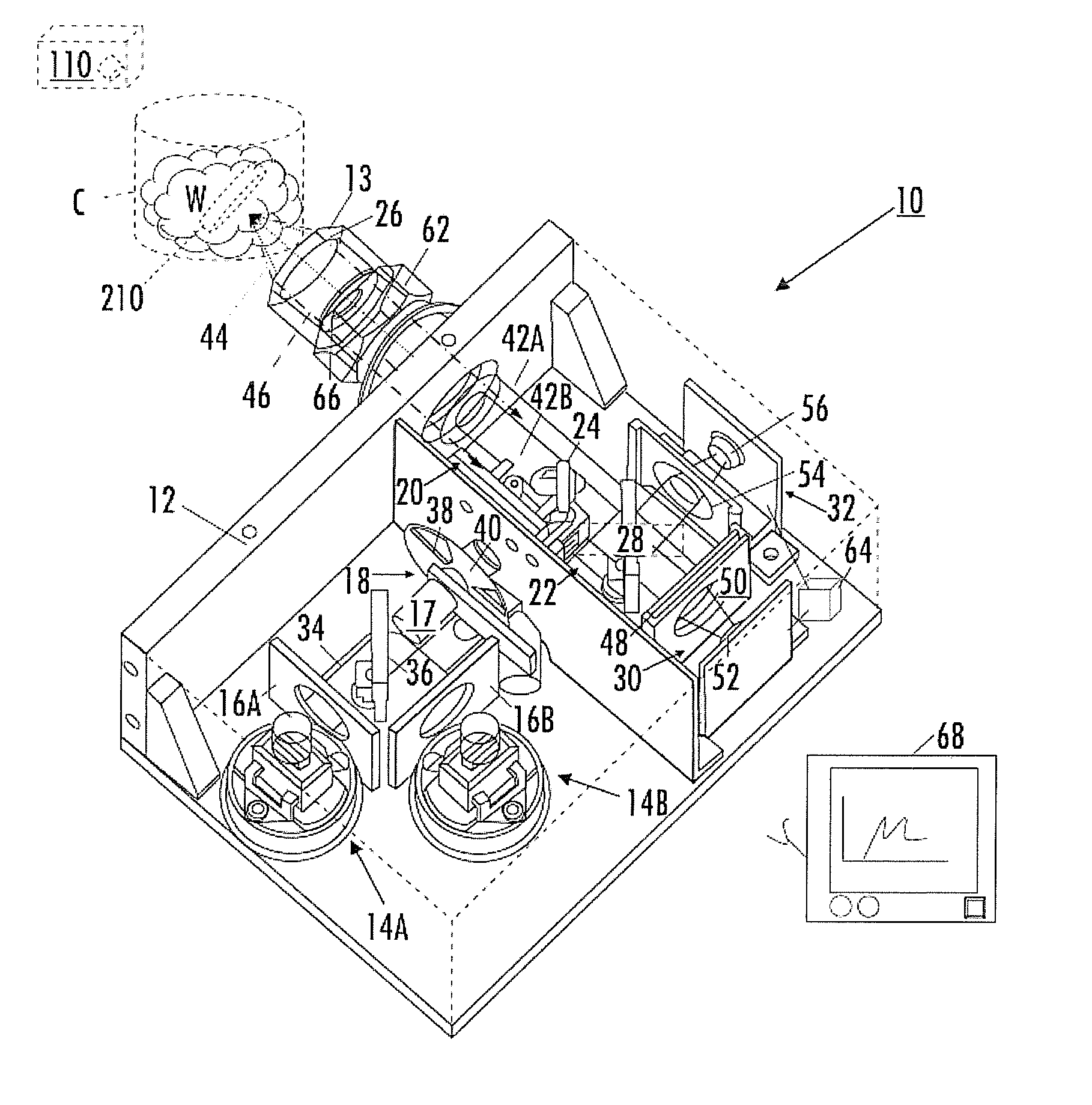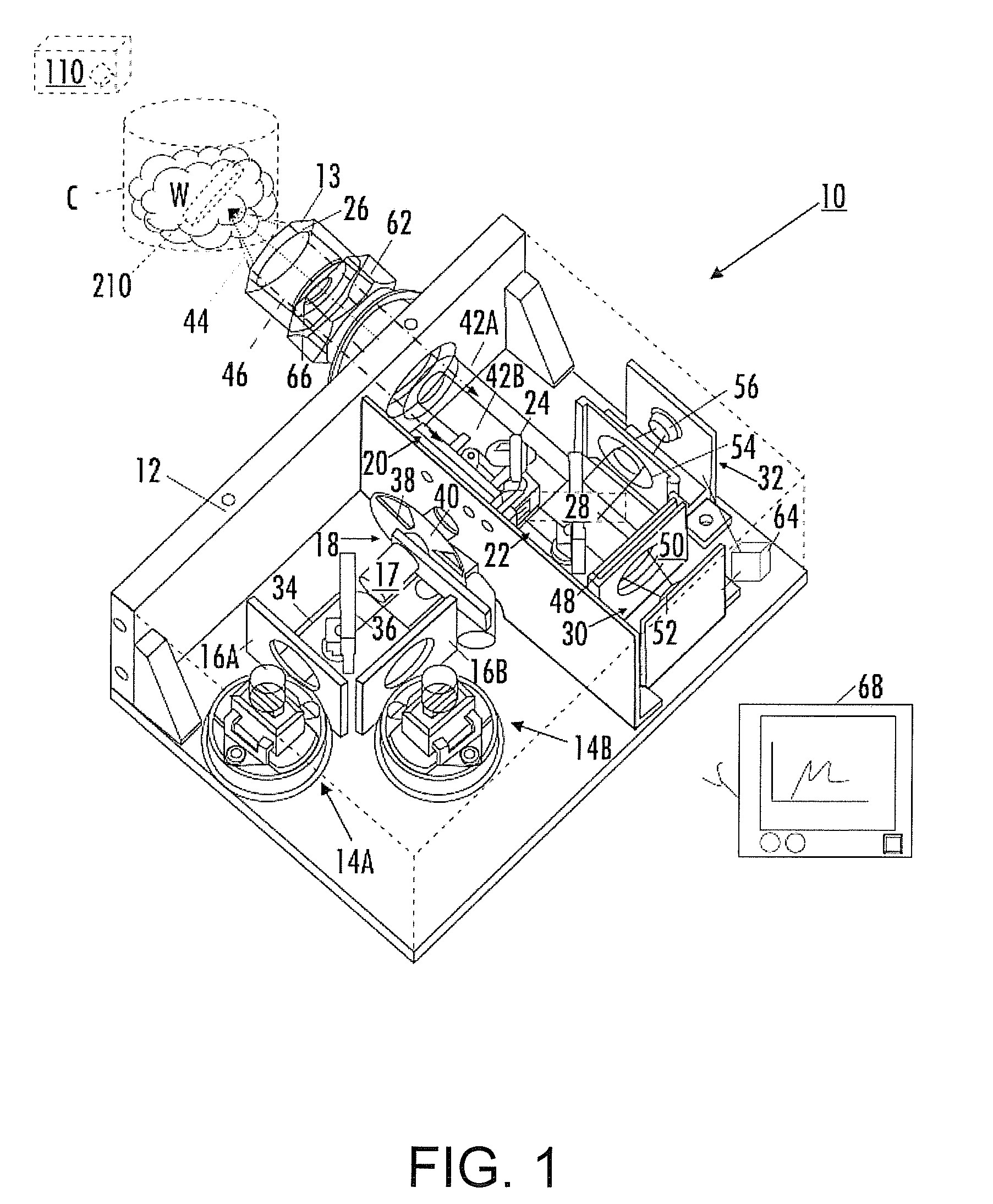Tablet analysis and measurement system
a technology of tabletops and measurement systems, applied in the field of optical analysis systems, can solve the problems of inability to accurately measure the data relating to one, unacceptably inaccurate estimates, and difficult conversion of simple light intensity measurement to information, and achieve the effects of reducing measurement noise, improving measurement accuracy, and being simple and economical to manufacture, assemble and us
- Summary
- Abstract
- Description
- Claims
- Application Information
AI Technical Summary
Benefits of technology
Problems solved by technology
Method used
Image
Examples
example ii
[0156 / System II corresponded to a system similar to the optical analysis system 10 shown in the figures was constructed and used to make static measurements on aspirin / lactose and included components as follows:[0157]Illumination: 20 W Gilway lamp[0158]Spectral elements: 5 mm D2O, 5 mm Germanium[0159]Optical window: none[0160]Detector: PbS detector from New England Photoconductor[0161]MOE: specific to test conditions.
[0162]Procedure and Results of static testing using System II: A powdered sample with a known composition was placed in a dish and the system light beam was focused on the powder. The output of the detectors was monitored and recorded. Aspirin / lactose samples covering the range of 100% aspirin to 100% lactose were tested.
[0163]Example III / System III corresponded to a system similar to the optical analysis system 10 shown in the figures was constructed and used to make dynamic measurements on aspirin / lactose and included components as follows:[0164]Illumination: 20 W Gil...
example iv
[0170 / System IV corresponded to a system similar to the optical analysis system 10 shown in the figures was constructed and used to make static measurements on aspirin / lactose and included components as follows:[0171]Illumination: 5 W Gilway lamp[0172]Spectral elements: 5 mm D2O, 5 mm Germanium[0173]Optical window: none[0174]Detector: PbS detector from New England Photoconductor[0175]MOE: specific to test conditions.
[0176]Procedure and Results of dynamic testing using System IV were similar to the examples above.
example v
[0177 / System V corresponded to a system similar to the optical analysis system shown FIG. 3 was constructed and used to make dynamic measurements of water / hydraulic fluid mixtures. System V components included:[0178]Illumination: 20 W Gilway lamp[0179]Spectral elements: 5 mm Germanium[0180]Optical window: sapphire window[0181]Detector: PbS detector from New England Photoconductor[0182]MOE: specific to test conditions.
[0183]Procedure and Results of testing using System V: Samples of automobile brake fluid were prepared with various levels of water; e.g., between 0% and 3% water. The liquid samples in quartz cuvettes with a 2 mm path length were analyzed using the system. The cuvettes were placed horizontally on a moving platter; the system was located above the platter; and the conical mirror was located below the platter.
PUM
| Property | Measurement | Unit |
|---|---|---|
| real time | aaaaa | aaaaa |
| frequency | aaaaa | aaaaa |
| frequency | aaaaa | aaaaa |
Abstract
Description
Claims
Application Information
 Login to View More
Login to View More - R&D
- Intellectual Property
- Life Sciences
- Materials
- Tech Scout
- Unparalleled Data Quality
- Higher Quality Content
- 60% Fewer Hallucinations
Browse by: Latest US Patents, China's latest patents, Technical Efficacy Thesaurus, Application Domain, Technology Topic, Popular Technical Reports.
© 2025 PatSnap. All rights reserved.Legal|Privacy policy|Modern Slavery Act Transparency Statement|Sitemap|About US| Contact US: help@patsnap.com



